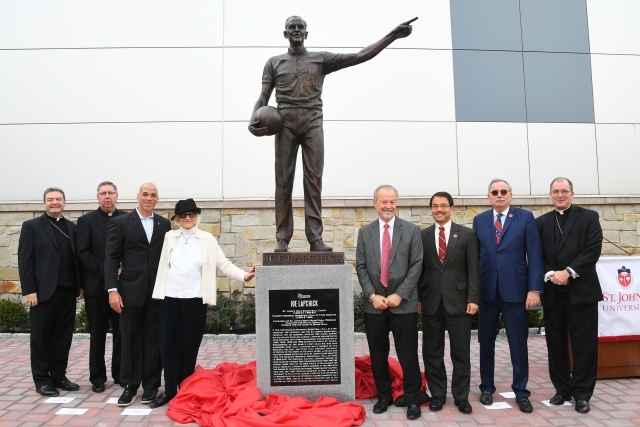
Dedicating a permanent memorial to a towering figure in Red Storm and American basketball history, St. John’s University unveiled an 11-foot-six-inch bronze statue of the late and legendary men’s basketball Coach Joe Lapchick at the Queens campus on Saturday, December 2.
The ceremony drew 140 alumni, benefactors, faculty, staff, and students, as well as members of the Vincentian community and the Diocese of Rockville Centre, NY. Speakers included Coach Lapchick’s son, scholar and human rights activist Richard E. Lapchick, Ph.D. ’67C, ’01HON, and Kevin F. Reed ’75C, Chair of The Peter J. Tobin College of Business Board of Advisors, who spearheaded efforts to raise funds for the statue. Robert F. Kalenka ’84CBA, ’91MBA, a member of the St. John’s Board of Trustees, also attended.
The Most Rev. John O. Barres, S.T.D., J.C.L., D.D., Bishop of Rockville Centre, and the Most Rev. Robert J. Brennan ’84C, Auxiliary Bishop of Rockville Centre, were among the dignitaries present for the ceremony. Also in attendance were three St. John’s sports giants: former men’s basketball Coach Lou Carnesecca ’50C, ’60GEd, ’00HON; former Athletic Director and former head baseball Coach John W. “Jack” Kaiser ’49C; and alumnus and current basketball Coach Chris Mullin, a Naismith Memorial Basketball Hall of Famer, former NBA star, and Olympic gold medalist who led St. John’s to the 1985 Final Four.
Dr. Gempesaw addressed the guests. “Some of you may know,” he said, “that 110 years ago, almost to this day, the St. John’s basketball team played its first game on December 6, 1907. Since then, St. John’s has been ranked among the top 10 Division I men’s college basketball teams with the most victories. This winning record and outstanding reputation would not have happened without the strong foundation built by those individuals who have led St. John’s basketball teams. Today, we celebrate the significant contributions of one of those leaders, Joseph Lapchick.”
Dr. Gempesaw thanked Dr. Lapchick and his sister, Barbara Lapcek, for joining the “celebration of their father’s lifetime accomplishments, particularly his efforts in establishing a winning tradition here at St. John’s and for helping others in promoting equality—consistent with our Catholic and Vincentian mission.”
The emphasis on excellence and justice defined Coach Lapchick’s career. Playing with the Original Celtics in the 1920s, the six-foot-five center earned a reputation as the game’s first “agile big man.” He served as Head Coach of St. John’s basketball for 20 seasons (1936–47 and 1956–65), guiding the team to four NIT championships. As Coach of the New York Knicks (1947–56), he was the subject of public criticism for signing the NBA’s first African-American player, Nathaniel “Sweetwater” Clifton.
The ceremony took place in the courtyard between Carnesecca Arena and the Taffner Field House. Anton Goff, St. John’s Director of Athletics, began the program by speaking of Coach Lapchick’s “profound impact on the St. John’s basketball program and the game of basketball as a whole.”
In his remarks, Mr. Reed recalled his efforts to establish the memorial. “The genesis,” he said, “started with a TV program about the life of Coach Lapchick. After viewing the program, it occurred to me that there was virtually nothing on the St. John’s campus recognizing Coach Lapchick, and I wanted to see if that could change.”
He contacted August M. “Gus” Alfieri, Ph.D. ’59C, ’64GEd, a member of the 1959 NIT Championship team and author of the biography Lapchick: The Life of a Legendary Player and Coach in the Glory Days of Basketball. Joined by Mr. Alfieri’s teammates—Louis F. Roethel, Ed.D. ’60C, ’62G, ’72GEd and Richard S. Engert ’59C, ’61GEd—they held a fundraiser at the 21 Club. “We were ‘off to the races,’” said Mr. Reed, a former member of St. John’s Board of Governors, 2014 Spirit of Service Award recipient, and ardent supporter of Red Storm athletics, the University, and the Tobin College of Business.
Dr. Lapchick thanked the University for the memorial and for the opportunity to share his thoughts about his father. “I am very humbled,” he said, “to speak about my father on behalf of my sister, Barbara, and my wife, Ann. We will be forever grateful to St. John’s for creating this wonderful statue.”
Dr. Lapchick is Chair of the DeVos Sport Business Management Program and Director of The Institute for Diversity and Ethics in Sport at the University of Central Florida. He also is Founder and President of the National Consortium for Academics and Sports, which promotes justice through sports. “I call my dad the first activist coach and athlete,” he said. “He simply acted by doing what he felt was the right thing, the morally just thing, the ethical thing.”
According to Coach Carnesecca, Coach Lapchick “had that rare talent to get people with differing opinions to blend together.” Coach Kaiser added that Coach Lapchick “personified the word gentleman,” teaching “how to conduct ourselves on and off the field of competition.” Mr. Carnesecca and Mr. Kaiser each began his career as an assistant to Coach Lapchick.
Dr. Gempesaw invited Mr. Reed, Dr. Lapchick, and Ms. Lapcek to help unveil the statue, aided by Mr. Goff, Rev. Barres, and Rev. Brennan. Rev. Richard Rock, C.M., Campus Minister for Athletics, blessed the statue. Mr. Reed, Dr. Lapchick, and Ms. Lapcek each was presented with a miniature replica of the monument at the University’s Red White Club Reception. Later, they joined fans at Carnesecca Arena to recognize the back-to-back NIT Championship teams (1942–43, 1943–44) led by Coach Lapchick and to cheer on the Red Storm Men’s Basketball team as they defeated Sacred Heart, 90 to 55.
